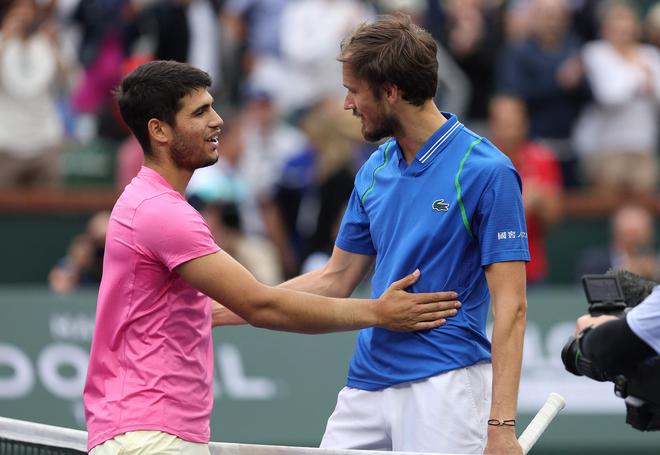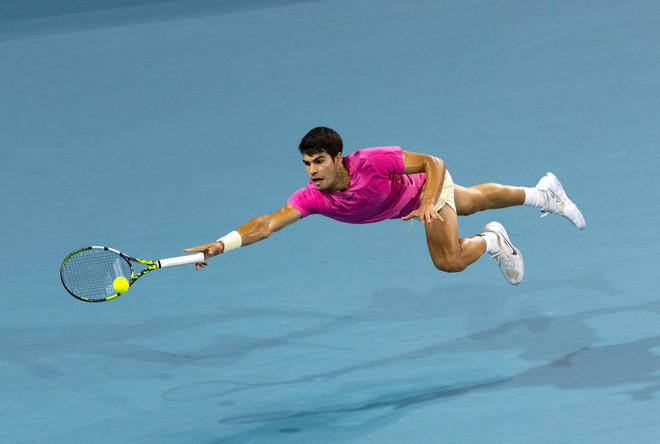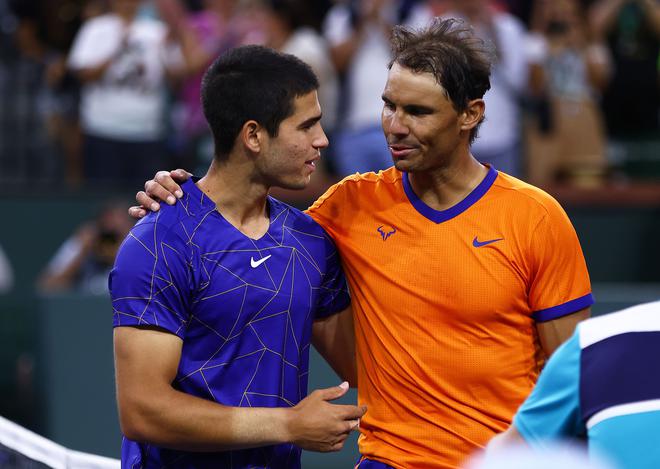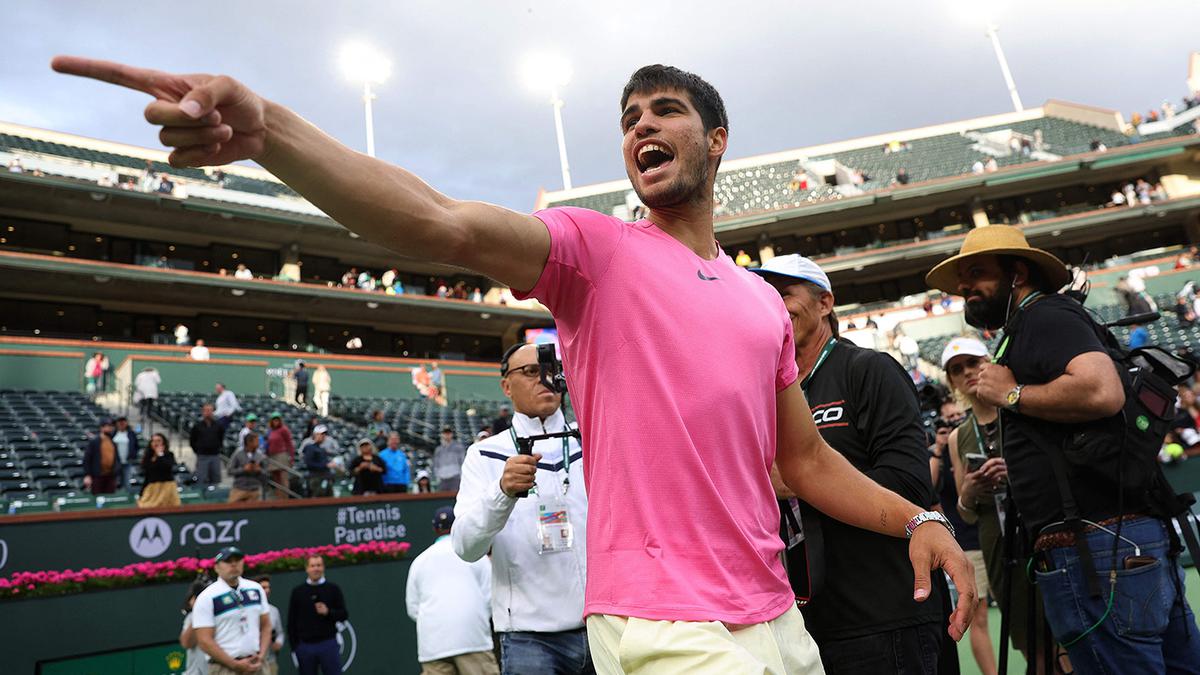Last year when a reporter asked Roger Federer —“What will your fans do when you retire?” — he replied, “They’ll fall in love with someone else.”
Many have already become smitten with Carlos Alcaraz. The smiling Spaniard has modeled his game after Federer and, at 19, has already succeeded beyond almost everyone’s wildest expectations.
Even though the Mighty Fed made a very tough sport look extremely easy — with his lithe movement and sublime shot-making inspiring the renowned essayist David Foster Wallace to write,“The metaphysical explanation is that Roger Federer is one of those rare, preternatural athletes who appear to be exempt, at least in part, from certain physical laws” — Alcaraz is even more athletic and creative. Every match of his is nothing less than a human highlight film.
“Everyone loves to watch Alcaraz because you don’t know what will happen next,” said Tennis Channel analyst Jason Goodall. “It could be the shot of the tournament.”
Jim Courier, who rose to No. 1 more from grit than glitz, also nailed the ‘Alcaraz Appeal’. “His instincts are to finish, finish [the point], whether it’s after a forehand, a serve, or a drop shot. He’s like a daredevil out there. He’s awfully fun to watch.”
Alcaraz has become a fan favourite off the court, too, because of his outgoing, upbeat personality. Much like Federer, he’s never too busy to sign autographs and do selfies with his admirers, even minutes before a prestigious final.
After Daniil Medvedev got mauled by Alcaraz in the BNP Paribas Open final, the Russian told the crowd, “Congratulations to you, Carlos. You are the most respected player. I think you say ‘hi’ to 300 people a day.”

Duel to savour: Alcaraz and Daniil Medvedev after the former’s win in the final of the BNP Paribas Open.
| Photo Credit: Getty Images
Carlos needed a trio of five-set wins to capture his first Grand Slam title at the US Open last September. When the ever-improving teenager recently won Indian Wells for his third Masters 1000 title, he outclassed six opponents, all in straight sets. Most impressive, he defeated No. 10 Felix Auger-Aliassime 6-4, 6-4; No. 13 Jannik Sinner 7-6 (4), 6-3; and No. 5 Medvedev 6-3, 6-2. Last year, Sinner beat Alcaraz on Wimbledon grass and Umag clay and led him two sets to one on US Open hard courts before succumbing. On the slower Indian Wells hard courts, the 21-year-old Italian had a set point before settling for a tiebreaker in the opening set.
Alcaraz’s team shouted at the hyperactive kid to stay calm. Carlos pulled ahead 4-3 with a backhand passing shot winner. Then he made an incredible backhand get before Sinner missed a forehand for 6-4. Finally, he delivered the coup de grace with a crosscourt backhand winner.
The shot of the match, not surprisingly, came from Alcaraz’s forehand and on a game point.
He ended a sensational power rally with an improvisational flick top-spin lob winner over Sinner to surge 3-0 ahead in the second set. Serving for the match at 5-3, Carlos started with a 137-mph ace, hit another forehand passing shot, and finished off Jannik with two rocket forehands.
‘A little bit of everything’
Afterward, the Spaniard wrote — ‘ un poco de todo’ (a little bit of everything) — on the courtside camera lens. Quite an understatement!
A slight betting favourite to end Medvedev’s 19-match winning streak in the final, the modest Alcaraz said, “He’s a wall. I have to make, let’s say, everything perfect.”
Alcaraz battered down that wall like an ancient Roman legion after besieging an enemy city. Displaying everything in his vast arsenal, he reeled off 12 of the first 15 points. A bullet backhand winner broke the Russian for 2-0 and provided the momentum he needed for a decisive 6-3 set.
An excellent offence beats an excellent defence in almost every sport, and Alcaraz raced to a 3-0 lead in the second set with two service breaks, the latter coming on a huge forehand, his signature shot. The versatile Spaniard boasts much more than brute power, though. On game point for 4-0, Carlos ‘The Speedster’ engaged in an extended rally and out-steadied Medvedev.
How about some torture to add to the entertainment? “Competition is grand,” tennis historian Ted Tinling once wrote, “but people also like watching a victim twitch. In fact, some prefer it.”
Serving at 4-1, 15-all, Carlos ‘The Sadist’ feathered three diabolical drop shots into the wide-open court for winners. The confused and deflated Medvedev was so far out of position that he didn’t even run for the balls. Not since the magical Federer had a champion toyed mercilessly with such a worthy opponent.

In flight: Alcaraz has mesmerised everyone with his electric approach to the game of tennis.
| Photo Credit: Getty Images
Tactically precocious, Alcaraz often exploited his opponent’s absurdly deep serve-return position, from at least 20 feet behind the baseline. So, in the final game, Carlos ‘The Artist’ twice showed off some old-fashioned but still valuable serving and volleying.
Looking like Stefan Edberg, he stung a backhand volley winner, and then with a nod to John McEnroe, he massaged a forehand drop volley winner.
“It was a highlight show for over an hour today,” marvelled Tennis Channel analyst Paul Annacone, who formerly coached superstars Federer and Pete Sampras. “We just saw a level we rarely see in a tennis season. It’s an absolutely astonishing level of tennis this kid can play.”
A spectator raised a sign proclaiming — King Alcaraz .How long will this charismatic teenage king reign? “A lot will come down to health,” said Courier. “He’s on a trajectory to win double-digit Slams if he’s healthy enough.”
Alcaraz missed the Australian Open when he injured a muscle in his right leg “through a chance, unnatural movement in training,” according to his January 6 tweet.
Blessing in disguise
The injury, though frustrating, proved a blessing in disguise. At the Players’ Voice Award last March, Carlos told Eurosport that he and his team of eight analysed what he was doing wrong. “We concluded that it is important to do the right things off the court as well as on it, and I wasn’t always doing that 100%. I’m talking about rest, nutritional supplementation, eating well, etc. There were a number of things that maybe I wasn’t doing right. Through the injury, I learned that I had to get back to the routine I had previously, to get back to doing all those things right to be at my best. I think that because of the injury, I’ve been doing that now, and it’s no secret that when you do things right, good results will follow.”
Alcaraz’s post-injury learning process also focused on his mental game. “I had to be calm and it has helped me mature a lot off the court,” he revealed. “These were not easy days for me, they were quite hard. I had to stay focused and train to come back stronger. During my recovery, as I have done on several occasions, I worked a lot with my psychologist. She helps me a lot both on and off the court. The off-court side is almost more important, as you spend most of your time there.”
Although Carlos is often likened to Federer and his boyhood idol Rafael Nadal, he said, “I have my own identity while playing. I always try to play ‘happy’ tennis. I consider myself a happy person off the court, so I try to play that way. I think that, nowadays, tennis is very dynamic — going up to the net, drop shots, big shots; that’s what attracts attention. I try to enjoy myself on the court and not make everything too monotonous. I try to create, and produce, rare, beautiful shots.”

Dream moment: Alcaraz congratulates his idol Rafael Nadal after the latter’s semi-final win at the Indian Wells Masters in March last year.
| Photo Credit: AFP
What could be better for tennis than a new, captivating champion producing mind-blowing shots against other rising stars and ageless legends?
Novak Djokovic and Nadal, currently tied with a record 22 Grand Slam titles, should provide the toughest competition for Carlos. Neither legend played Indian Wells and Miami, for different reasons. Djokovic isn’t allowed to travel to the U.S. because he adamantly refuses to get vaccinated for COVID-19.
“I have no regrets,” Djokovic said in a March 21 CNN interview. “It is the current state or current situation that I hope will change for later this year for the US Open. That is the most important tournament for me on American soil.”
As for Nadal, who has been injury-plagued throughout his 20-year pro career, he was hampered by a painful left hip injury at the Australian Open where 65th-ranked Mackenzie McDonald upset him in the second round. He has also withdrawn from the Monte Carlo Open, a tournament he’s won a record 11 times.
“I always say that if you want to be the best, you have to beat the best,” said Alcaraz, who regained the No. 1 ranking on March 20.
Carlos will likely get a chance to do just that against Djokovic and 14-time champion Nadal at the French Open, if not sooner on the European clay court circuit.
Can the last two of the iconic Big Three hold off their biggest New Generation challenge? The sports world can hardly wait to find out.


